Introduction
The use of email has become almost mandatory in most U.S. workplaces. The number of U.S. workers with Internet access at their workplaces has grown from under 30 million in March 2000 (the first month the Pew Internet & American Life Project began to monitor Americans’ Internet use) to over 57 million in October 2002. Almost all (98%) of these employed Americans have email accounts. Most American employers have provided Internet access with email accounts to employees hoping that this will help them become more collaborative with colleagues and customers, and thus more productive in their work.
But recently, the public imagination has been hit with warnings that whatever boons email provided at work have been compromised by a deluge of unwanted electronic communications. Emailers’ war stories are familiar by now: A California journalist says he receives a staggering 1000 spam a week.27 A director of an international relief group, worried about employees’ productivity loss, considers instituting an email-free day a week to liberate employees for tasks at hand. Employees of a mid-sized company complain of being held hostage by unending reply-to-all loops of colleagues’ office banter.
Many industry watchers predict the worst is yet to come. The numbers reported vary wildly: There are estimates that 7.3 billion emails are sent per day28, or 31 billion emails are sent per day; predictions that volume will double in 3 years29, or that volume already increased 14% in two months30; estimates that corporate email is growing 30% a year; claims that 10%31 or 20 – 40%32 or 30%-50%33 of email is spam; that spam is doubling every 6 months34; that spam increased 46% in two months35; that each Internet user received nearly 600 spam messages in 200136, or over 140037; that spam counts will double or triple in 200238, or triple by 2006, or reach 3800 by 200639. The numbers come from parties with differing agendas: reporters, independent or hired analysts, software companies that serve up email or build spam filters.
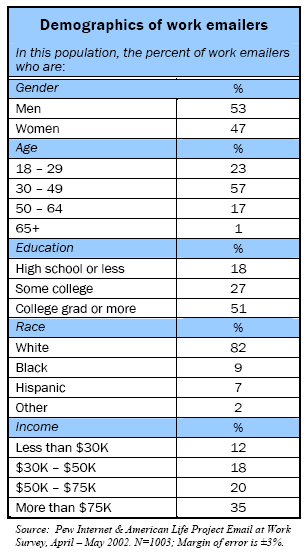
Even the lowest of these estimates is dramatic, and the personal stories are compelling and ring true – especially to those in certain professions that rely heavily on email communications. These are two of the major reasons the Pew Internet & American Life Project decided to study people’s use of email for their jobs – both in their workplaces and in other locales where work-related email is exchanged. We wanted to get a sense of how much email workers generate and receive, how email is used, what it’s good for, and where it falls short. We wanted to ask the growing legion of work emailers how they feel about this relatively new communications tool. Do they like it, tolerate it, or dread it? And how is email affecting workers’ on-the-job habits? Does it help them complete tasks, or does it divert them from those tasks? We aimed to get workers’ assessments of how their email use has changed the workplace culture. And finally, we hoped to probe the direction of work-related email in the coming years.
For this survey, 2,447 Internet users were polled by telephone during April and May, 2002. We can say with 95% confidence that the error attributable to sampling and other random effects is plus or minus 2 percentage points. Of those sampled, 1,003 use email at work. For this group, the margin of error is plus or minus 3 percentage points.
While we listened to the familiar narratives about email-oppressed workers, we were surprised to discover another story about a much more moderate, tempered – and far more widespread – picture of email’s role in people’s work lives. The snapshot of a typical American work emailer is of someone who spends roughly a half an hour of the workday processing email, including up to about 10 incoming messages and 5 outgoing ones. The typical worker is as likely to have seen no change in email volume over the last year as to have seen it rise.
Moderation in all things: Email volume and time spent on email
A small number of the truly inundated work emailers have created most of the buzz about email overload. About 15% of work emailers process more than 50 emails a day. In comparison, the vast majority of work emailers handle a smaller, more reasonable amount of email on the job. Almost two thirds of work emailers process 15 or fewer emails a day. They generally receive more email than they generate. Sixty percent receive no more than 10 emails a day, and 63% send no more than five.
Three-quarters of work emailers spend an hour or less on their daily email. That includes almost a quarter who log fewer than 15 minutes a day on their work email. Once again, a very small minority spend a very large amount of time on email; 4% of workers spend more than 4 hours a day doing email.
About half of all workers who do work-related email say their volume has remained steady over the last year; and about half say it has increased. Twenty percent say it has increased “a great deal.”
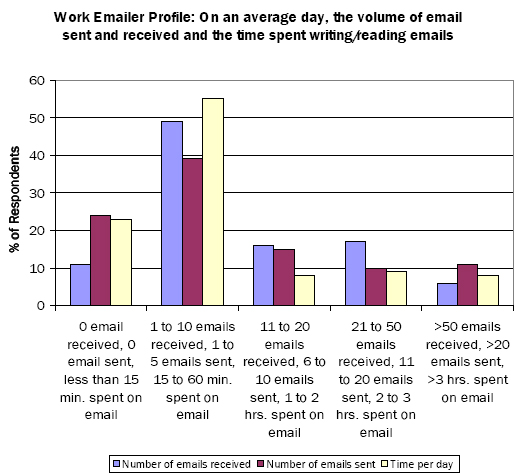
Logging onto email is as easy as, or easier than, checking voicemail and has become ingrained as part of the American worker’s daily to-do list. Almost all work emailers (88%) check their inboxes at least once a day, and most of those (70%) check at least several times a day. Thanks to the popularity of email software with an always-on feature that leaves inboxes open, nearly a quarter of work emailers say they “constantly” check their email.
The moderate volumes and attentive behaviors result in timely handling of email. Nearly half of work emailers (44%) respond to most of the email they should respond to immediately, as it comes in. Another 38% answer it by the end of the day. Ten percent answer within a few days. Three percent give up and never answer email they know they “should” respond to. One heavily burdened executive told us, “Eventually, if it’s important enough, they’ll send it again, or telephone.”
Email has had a minimal spillover effect on the working day. Seventy-eight percent of work emailers say that email hasn’t affected the number of hours they work. But when email does affect time spent working, it is more likely to increase rather than decrease the hours at work. Fourteen percent of work emailers say they work more hours, while 8% say they work fewer hours because of email.

[that is]
The stuff of email – what workers use it for
Work emailers are serious about the content of their email. More than half say that almost all (over 80%) of their incoming and outgoing messages are work related. About three quarters of work emailers say that almost none of their emails (under 10%) are personal or spam.
No doubt, this focus on substance leads to work emailers’ high regard for the value of their email. More than half of work emailers rate their email from 8 – 10 on a ten-point scale, where the highest rating describes email as being “essential” to their work. Nine percent rate it 1 – 3, or a waste of their time.
Work emailers are clear about when and where email works well and works poorly. When comparing telephoning, in-person conversation, and email exchanges, email proves best at processing both some of the most simple and most demanding work tasks.
Almost two thirds of work emailers (63%) found email to be the most effective means for making arrangements and appointments in their work lives. Email is an instant advantage in national or global companies for keeping far-flung employees in the loop. It’s a godsend for last-minute round-ups or heads-ups. More than three quarters of work emailers agree (77%) that email has made it easier for them to keep up with events at work.
Workers also prefer email for some of the detailed and serious work they do. Over two thirds of work emailers (67%) find email most effective for reviewing and editing documents. Document attachment, now so popular, seemed almost miraculous in its early days, bypassing cumbersome faxes, excessive copying, and slow exchanges via US mail.
When more complex communications are required —resolving issues, having a dialogue, even asking questions – work emailers concede that email is less effective. For example, work emailers think personal conversations work better than email for raising questions about work; 44% of work emailers prefer in-person conversation, compared to 36% who prefer email. When issues get even more complicated, work emailers prefer face to face encounters hands-down; a scant 6% consider email effective for bringing up problems with supervisors; 4% consider it effective for dealing with sensitive issues.
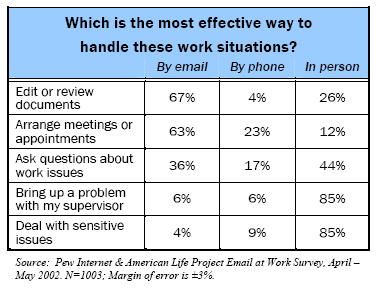
In a previous Pew Internet Project study of how local government officials use the Internet, we asked respondents to evaluate email as a communications tool between those governing and the public. Government officials, echoing sentiments from this current study, suggested email is not as effective as other communications in situations requiring some level of complexity or sensitivity of discussion. Government officials said email was “not very effective” in engaging the public in debate. They agreed email helped citizens take a first step to “participate” in debate by registering opinions, but went on to say that email was less effective in the more complex, next steps of actually building consensus or clarifying opinion.40
Email’s limitations derive from its nature as a medium, of course. Email lacks the nonverbal “information” that is conveyed in face to face conversations, the rich body language, visual cues, subtle strokes of timing, or feedback. Email’s counterpart vocabulary of emoticons – the happy faces, punctuation peppering, stage whispers – can be poor, and often annoying substitutes. Even telephone conversations capture tone of voice, meaningful pauses, the hesitations and rephrasing that are absent in emails. Both of the real-time exchanges enable clarifications and give and take that are so necessary, especially, in sensitive communications. Email just sits out there, often abbreviated, often hastily written, impulsively sent, and an easy target for misinterpretation.
Spam: The real story at work
On a typical day, one attentive spam counter reported to us, her inbox spam score would be: personal AOL account 5; corporate account 0. The inventory of spam in the personal account after this emailer’s two week vacation was as follows: 200 personal emails received; 75 were pure spam. Of those, 25 related to money-making schemes, 18 featured pornography or sexual content, 3 were obvious viruses, and the rest were a miscellaneous collection of unsolicited announcements and offers.
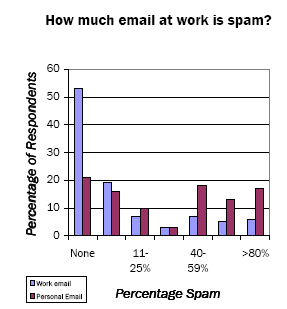
This work emailer’s description of her corporate inbox – zero spam – is at odds with most news accounts about the volume of spam now assaulting the workforce’s email accounts. Current spam estimates, while varying wildly, are uniformly staggering: 4 million spam attacks in a single month against one email security firm’s corporate clients41; 38% of over 3 billion emails – over 1 billion pieces of spam – were handled by another filtering company42; reports of 10% – 30% of work email content as spam; a 15% increase in spam detected by one email security company in a single month43. However impossible it is to achieve accurate measures of spam, every reasonable person would agree the amount of spam is significant and growing.
However, two largely underreported facts about spam suggest the situation looks different and less gloomy for those with email accounts at work. First, the disbursement of spam is very uneven and second, most spam doesn’t reach email accounts at people’s work places.
According to our survey results, relatively little spam is finding its way to at-work email inboxes. More than half of work emailers (52%) reported no spam in their email accounts. Another 19% reported less than 10% of their incoming mail at work was spam. Eleven percent reported about two thirds or more of their inbox was spam. By contrast, 21% of respondents reported no spam in their personal accounts; another 16% reported less than 10% incoming spam. Thirty percent reported about two thirds or more of their incoming email personal email was spam.
Why are at-work email inboxes largely protected from spam? One reason is that business or organizational accounts are small prey compared to the rich targets presented by the big email providers like AOL, MSN, Yahoo, or Hotmail. Spammers find it worth their while to go after even a portion of the tens of millions of email accounts at these popular dotcom addresses. It is relatively easy to grab hold of screen names with cheap simple software that generates random user names from tables of common first and last names. Spammers blanket these lists, and the success rate, while far from perfect, is good enough. “It’s like shooting fish in a barrel instead of a lake,” said one information technologist.
Outside the workplace, the Internet playing field is graded to favor determined spammers over new email users. Simply signing up for services can catch the unwary off guard and doom them to being a spammer’s target. At Yahoo, new users must unclick boxes to avoid receiving promotions and polls. At Hotmail, registrants must unclick the “Internet white pages” box or suffer these consequences: (your)“Hotmail e-mail address will be automatically listed in one or more Internet e-mail directories so others can look you up and send you messages!” AOL’s latest version 8.0 on the other hand, inaugurates a “report spam” feature that at least gives users revenge to tattle on spam, and MSN 8 boasts a new and critically acclaimed Junk Mail Filter.
Companies and businesses, besides being smaller targets, often take defensive measures against spam. They install server side filters, or email clients with junk mail filters, or spam-fighting services that kick out or divert spam before it reaches inboxes. Such technologies abound, with varying degrees of sophistication and success. Some employees resist automatic filtering for fear of losing valuable mail. One infamous case of mistaken spam identity occurred in the fall of 2001, when hundreds of notifications from Harvard’s admissions office to applicants with AOL screennames went undelivered, because the AOL filters mistakenly kicked out the messages as spam.
As a further preventive measure, many companies educate their employees in Web behavior, advising them on how to avoid being snared by spam traps: never respond to spam, thereby signaling your account is live; never post your real email address in chat rooms or on message boards or untrusted Web sites, where they can be conveniently plucked by spammers assembling lists. Unfortunately, even a small slip by one employee – an address posted publicly – can have broad and long-lasting repercussions, getting certain domain names onto spammers’ radar and opening up lots of employees to spam lists.
While these and other anti-spam efforts have been largely successful in holding spam at bay, there are costs. Some are financial: One company estimates the price of spam at $1.00 per piece in lost productivity44. A technology company has constructed a cost-ofspam calculator that predicts a company of 500 employees who receive 5 spam per day and take 10 seconds to delete each one, costing $40,000 in salaries and 105 days of productivity.45 Such costs are probably not paid in the few seconds it takes for an employee to hit the “delete” key. But the salaries of Information Technology workers, the purchase of anti-spam applications or services, the cost of extra servers or bandwidth required to deal with incoming (yet ultimately diverted) spam, and the expense of educating employees in anti-spam behaviors all take an economic toll.
Another cost of spam is less measurable – what spam takes away from the general wellbeing of employees. One IT administrator at a mid-size company explained that the firm’s employees don’t complain about the minimal time lost in deleting their fairly small amount of junk mail. “They’re willing to deal with that; it’s part of the modern world,” he said. But rather, he explained, what really bothers employees is the kind of sickening feeling they get from the daily assault of barnyard subject lines.
Fighting spam will continue on many different fronts. Public annoyance will lead to legislative proposals. Federal Trade Commission rules and regulations will be enforced. Workers who rely on email to do their jobs will learn to protect themselves. Technology wars will escalate between spammers and spam fighters. It is conceivable that the ultimate defense against spam will involve a reversal of the basic logic of email transactions. Until now, email has worked on a fundamentally open model: anyone who knew your e-address could send you a message. Some industry experts suggest that spam will force a change to a “closed” or “permissive” model, in which the owner of each email inbox will specify the senders from whom messages will be accepted. All others will be rejected. Already market forces are beginning to have their say.46 One bulk emailer reported that the steps he needs to take to get around spam filters have driven up his operating costs 1000% this year, making it a much less lucrative business.47
Ambience of the workplace: email’s good contributions
Email is a powerful communications tool, one with potential for a deep impact on both relationships and mood in the workplace.
We have seen in past Pew Internet Project research that email is a strong force for connecting people. We have found that personal email tends to extend people’s social networks. About a third of email users communicated with more people because of email—usually by maintaining friends-and-family relationships or reconnecting with those from their past with whom relationships had withered.48 In another study of local government officials’ use of work email, we found that email enabled over half the officials to make contact with citizens they hadn’t communicated with before.49 In this study, we find email extends and strengthens social ties in the workplace in even greater numbers than previously reported. Nearly three quarters of work emailers say email helps them communicate with more people. Almost two thirds say email makes them more available to co-workers. Sometimes, an email relationship can make co-workers feel like they “know” each other, although they have never actually met.
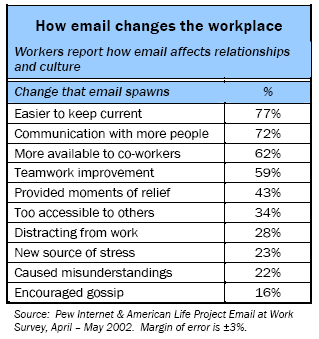
Well over half of work emailers (59%) say that email improves teamwork, a likely benefit reaped from email’s twin contributions to improved social relationships and enhanced information and work flow.
Savvy managers and executives capitalize on the personal touch that email’s broad reach can have on human relations in the workplace. A boss can blanket a company with good-news announcements, or impulsively dispense individual virtual kudos, or invite “personal” correspondence from employees. Such email exchanges can serve to flatten hierarchies. In one bi-coastal company of 700 employees, restroom gossip would frequently include the astonished reports that the CEO – sitting three time zones and 2,500 miles across the country, actually responded to a personal query from a low-level employee.
Email tends to loosen up the culture of a workplace. Close to half of work emailers (43%) find that email, often likened to a virtual water cooler, provides some relief during their work day. Thirty-nine percent of work emailers send or receive jokes and chain letters; a quarter chit chat about personal lives; 15% gossip.
But email, like the water cooler, harbors a dark side. More than a quarter of work emailers (28%) find the temptations of email distracting to their work. A small number (16%) think email actually encourages the office gossip. And nearly a quarter say email creates misunderstandings (22%) and more stress (23%).
The ethics of email: Right and wrong, trust and mistrust, and tolerance for the tightening of rules and regulations.
For most emailers, sloppy or shady email habits carry few consequences. But for others, sending inappropriate content and mishandling or misuse of email spell disaster. As early as the 1980s Iran Contra case, critical evidence came from emails that were supposedly deleted but still lurked on the computer in recoverable form. In the summer of 2002, email evidence figured strongly in the trial of Arthur Andersen for its accounting practices at Enron, and the SEC took aim at six major Wall Street firms for deleting emails before the 3-year statute of limitations. Hewlett Packard suspended 150 employees for sharing inappropriate content via email. Email messages were drawn as ammunition against Microsoft, Merrill Lynch, Martha Stewart – the list goes on. About 10% of work emailers say they have accidentally sent an embarrassing email to the wrong person at work, but few have faced the consequences that researcher Stephen Martin did when he accidentally sent an email to the wrong person. Martin spent 10 months of the year 2000 in prison under the federal Economic Espionage Act for stealing trade secrets through email.50
Past research shows that employers and employees share a clear sense of the right and wrong ways to use their business email. In a survey conducted in 2000, both groups believed the worst transgressions of email use were harassing co-workers (over 90%) and circulating pornographic material by email (over 85%).51 About half felt personal use of company email was an ethical violation, but this ranked 13th of 14 on a list of ethical violations, including falsifying personal information, misleading customers, to whistleblowing by employees on illegal or unethical company actions (which ranked last.)
Surveys indicate that both employers and employees apply a common sense rule for how much personal emailing online is appropriate. Over 500 Human Resources managers in England recently surveyed in England said that 20 minutes a day of personal Web time is “fair and acceptable.”52 In our survey, three-quarters of work emailers said that almost none (under 10%) of the email they handle at their work is personal.
Email and productivity
Since the high tech era began, there has been an ongoing debate on how information technology affects productivity. For nearly two decades, economists have debated whether increased processing and communications speeds brought about by computers is more valuable than the potential for extra distraction and tinkering that they bring. This study was not intentionally designed as an economic measure of worker productivity, as was a 2000 survey demonstrating that office workers could gain 14% – 20% in productivity.53 Nevertheless, our findings contribute to, without resolving, the debate.
Our research about email in the workplace provides soft evidence for both sides. But by and large, we would argue that workers feel email is a positive force on work emailers’ productivity.
Email stands out as a time saver: In this study, an overwhelming number of work emailers, 86%, report that email saves them time. Forty-three percent say email has saved them a lot of time; an additional 28% report email has saved them some time; 15% say email has saved them a little time. Thirteen percent report that email has not saved them any time at all.
We have also documented some soft measures that support our sense that email improves productivity. Email contributes to affable worker relations, a smooth workflow, and individual professional-well-being.
Email has a positive effect on the social work environment: 59% of work emailers say email improves teamwork, 62% say email makes them more available to co-workers. Email is the tool of choice for effectiveness in many work tasks: two-thirds of work emailers prefer email for many work tasks, from managing schedules to editing documents. Work emailers like their email and consider it valuable: 71% consider email a generally positive force in their work lives. Half say it’s essential to their work.
On the other hand, email is a drain to productivity in other soft measures. These negative effects are recorded, however, in much smaller numbers. For up to about a third of workers, email can be stressful, encourage gossip, or otherwise create situations that distract from work.




